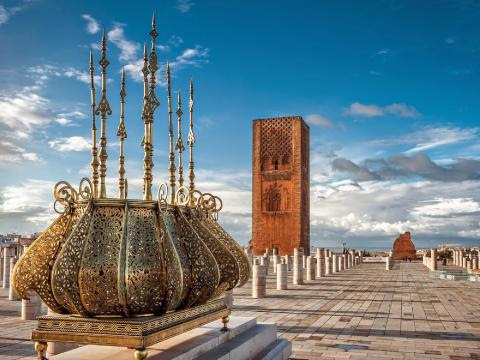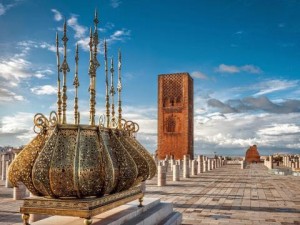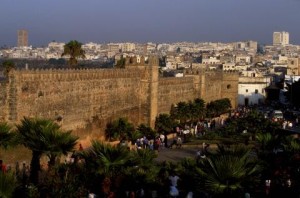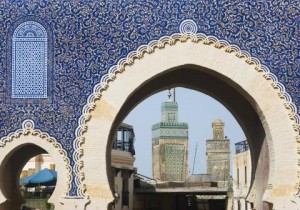Skyscanner
Laura Gavin
Writer
Rabat has long played second fiddle to Marrakech, but this city by the sea has a charming authenticity and enough up its sleeve to please both city weekenders and those looking to travel beyond Morocco’s mainstream tourist attractions. Read on for a closer look at Rabat, including the best things to do, plus information on how to get there.
Best things to do in Rabat
1. Visit the Hassan Tower
Though all that remains of Sultan Yacoub al Mansour’s ambitious twelfth century mosque is the minaret (the sultan died before it could be completed), it’s an iconic 50-metre tower that is hard to miss as you explore the city, guarded by the pillars that would have held up the roof of the mosque. The incredible, intricate designs are not repeated, so it’s worth a full 360° look around all four sides before you pose for that essential photo.
2. Haggle in Rabat Medina
Essentially what was the old town of Rabat, today the medina provides a snapshot of bustling Arabic bazaars, traditional cafes and the alleyways and shopfronts of daily life here in the capital. Located just south of the Bou Regreg river, this is the place to buy leather goods, lamps, Moroccan crafts and curiosities and Berber carpets. And since it’s not nearly as tourist-focused as Fez or Marrakech, you might find it a more leisurely – and even potentially cheaper – experience.
3. Indulge in some fine dining
Rabat’s food has been noticeably influenced by its history, with traditional tea rooms sat alongside 5-star French restaurants, Andalusian-inspired cuisine and all kinds of delicious European-Middle Eastern fusions. If you’re looking to sample the best Moroccan fare, stand out restaurants to try include Dinarjat in the medina, where you can pick your own dish using fresh local ingredients from the nearby markets and Le Ziryab on Rue des Consuls, home to a beautiful Moroccan courtyard. For a novel experience, Le Dhow is a seventeenth century wooden boat located near the Kasbah docks which also does excellent French food (the ‘discovery’ menu starts from 160dh for two courses*) plus live music most nights.
4. Walk through Bab Oudaïa into the Kasbah
A dramatic entrance into the old citadel, Bab Oudaïa is one of the finest examples of a Moroccan gateway you’ll see, though if it’s closed you may have to enter from the somewhat smaller entrance beside it. Once inside the Kasbah des Oudaïas, it’s a quiet idyll of residential streets built onto the clifftops, warren-like in their size and number and picked out in bright shades and patterned tiles. It’s free to visit the peaceful Andalusian Gardens at the southern corner of the citadel, and gaze out over lofty views of the mouth of the river and the bright turquoise sea beyond.
5. Enjoy a day on the beach
Make the most of the those long hours of sunshine and head to one of the city’s nearby beaches. Skhirat Beach is a popular choice, a half hour’s drive south of Rabat and home to the luxurious L’Amphitrite Palace Resort & Spa if you want to make a weekend of it. Alternatively, walk down to Rabat’s small but attractive shore, following the path to the left of the Kasbah. Watch out for rough waves if you’re swimming or surfing (sea temperature averages of 23°C make August the best month for this), or simply stroll up to the town of Salé on the opposite banks of the river and catch the magnificent sunset.
6. Go back in time at Chellah
Explore the extent of Rabat’s long history at Chellah, a Medieval Merenid fortress built onto an ancient Roman site, the ruins of which are still visible today. There’s also the remains of a mosque, a minaret and the royal tombs of Abu al-Hasan and his wife within the still-sturdy red walls. Chellah’s abandoned feel, complete with overgrown fig trees and nesting storks in the spring, only adds to the atmosphere. Located in Rabat’s metro area, you can reach it on foot from the medina.
7. Take a day trip to Fez
Heralded as the most beautifully preserved city in the Arab world, Fez looks like a work of art, from the striking blue tiles of the Bab Boujloud to the textiles on the giant weaver’s looms in the old medina. Peep through the doors of the city’s highly decorated and most famous holy sites, Kairouine Mosque and Zaouia Moulay Idriss II, shrine to the founder of Fez (non-Muslims are not allowed to enter) or try a slice of camel hump, a local delicacy, at the food souks – Fez is considered one of the best street food destinations in Morocco. Only a two-hour drive along the coast from Rabat (a little longer by train), the city is definitely worth a day out of your itinerary.
How to get to Rabat
Flights to Rabat from the UK go direct from London Stansted with Ryanair or with Royal Air Morocco from London Gatwick, with a journey time of around 3 hours 15 minutes. You can also get there with a stop at Paris Charles de Gaulle if you fly from Birmingham, Manchester or Heathrow.
Rabat-Salé International Airport is a five mile drive from the city outskirts, located in the town of Salé, north of the river Bou Regreg. You can get a direct train every hour from the airport to Rabat Ville, which is a good option since the main city railway station is found near the Ville Nouvelle and many of the main Rabat hotels.
Once you’ve arrived, it’s easy to get from Rabat to other tourist attractions in Morocco. There’s a network of national trains going on to destinations like Casablanca (just over one hour), Fez (2 hours 30 minutes) and Tangier (3 hours 35 minutes), while buses leave from Place Zerktouni, just out of the city, with connections to most cities in Morocco. Local taxis are divided into two types – ‘Petite’ taxis are only for short journeys around the city; if you want to hire a taxi to go outside Rabat, you’ll need a ‘Grande’ taxi.










